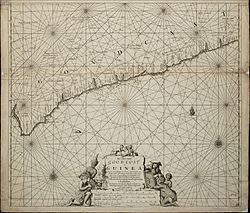
Back الشاطئ الهولندي الذهبي Arabic Costa d'Or Neerlandesa Catalan Niederländische Besitzungen an der Goldküste German Costa de Oro neerlandesa Spanish Alankomaiden Kultarannikko Finnish Côte-de-l'Or néerlandaise French חוף הזהב ההולנדי HE Նիդերլանդական Գվիանա HY Pantai Emas Belanda ID Costa d'Oro olandese Italian
Dutch possessions on the Coast of Guinea Nederlandse Bezittingen ter Kuste van Guinea (in Dutch) | |||||||||||||||
|---|---|---|---|---|---|---|---|---|---|---|---|---|---|---|---|
| 1612–1872 | |||||||||||||||
 The Dutch Gold Coast around 1675 | |||||||||||||||
| Status | Dutch colony | ||||||||||||||
| Capital | Fort Nassau (1612–1637) Fort Elmina (1637–1872) | ||||||||||||||
| Common languages | Dutch | ||||||||||||||
| Religion | Dutch Reformed | ||||||||||||||
| Governor | |||||||||||||||
• 1624–1638 | Adriaan Jacobs | ||||||||||||||
• 1656–1659 | Jan Valckenburgh | ||||||||||||||
• 1764–1767 | Jan Pieter Theodoor Huydecoper | ||||||||||||||
• 1816–1818 | Herman Willem Daendels | ||||||||||||||
• 1869–1871 | Cornelis Nagtglas | ||||||||||||||
| History | |||||||||||||||
• Established | 1612 | ||||||||||||||
• Disestablished | 6 April 1872 | ||||||||||||||
| |||||||||||||||
| Today part of | Ghana | ||||||||||||||
The Dutch Gold Coast or Dutch Guinea, officially Dutch possessions on the Coast of Guinea (Dutch: Nederlandse Bezittingen ter Kuste van Guinea) was a portion of contemporary Ghana that was gradually colonized by the Dutch, beginning in 1612. The Dutch began trading in the area around 1598, joining the Portuguese which had a trading post there since the late 1400s. Eventually, the Dutch Gold Coast became the most important Dutch colony in West Africa after Fort Elmina was captured from the Portuguese in 1637, but fell into disarray after the abolition of the slave trade in the early 19th century. On 6 April 1872, the Dutch Gold Coast was, in accordance with the Anglo-Dutch Treaties of 1870–71, ceded to the United Kingdom.[1]
- ^ Adhin 1961, p. 6


